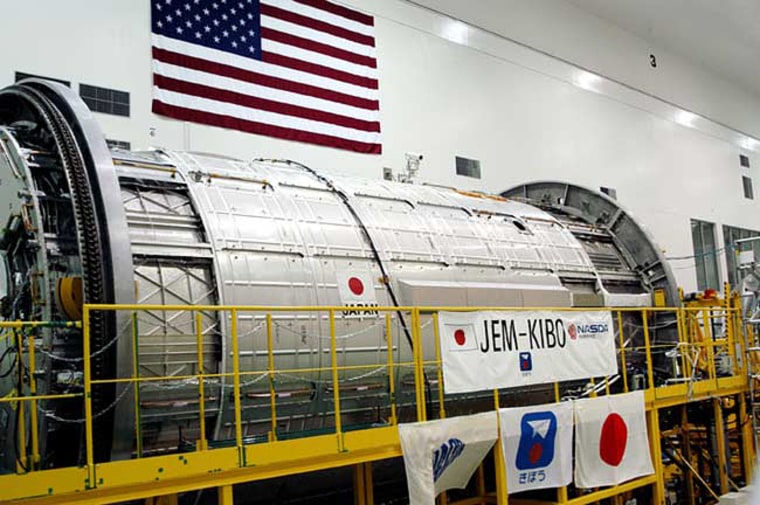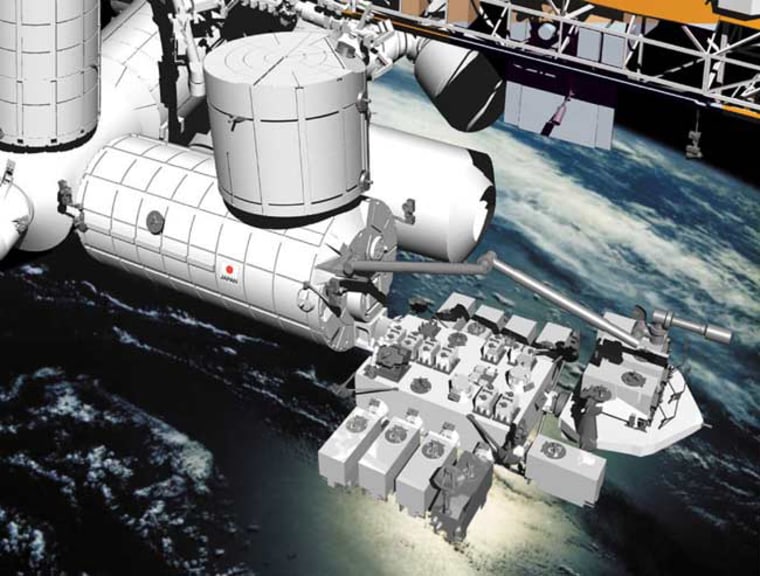There's a lot of hope packed aboard the shuttle Discovery, bound for the space station.
Kibo ("Hope" in Japanese) is set to be the newest, largest laboratory on the international space station. The tour bus-sized room built by Japan is scheduled to launch aboard Discovery's STS-124 mission Saturday afternoon from NASA's Kennedy Space Center in Cape Canaveral, Fla.
"This is a big milestone for the Japanese community," said Japanese astronaut Akihiko Hoshide, who will ride aboard Discovery as a mission specialist to help install his country's new lab. "A lot of people worked on this for 20-plus years, so this is really a mission to make a dream come true. It's the same for me."
The massive cylindrical room is 36.7 feet long and 14.4 feet wide. When fully-assembled, it will weigh 15.9 tons — about the heft of four adult elephants. It will fit up to 23 racks, which can each be loaded with equipment to conduct scientific research. So far, experiments are planned in fields such as life science, materials science and fluid mechanics.
One of the first experiments planned for Kibo is a study of how heat and atoms move within materials without gravity to pin them down.
"You're looking at surface convection and flow, and studying it in a way you couldn't possibly do on the ground," said Gregory Chamitoff, a mission specialist who will fly aboard Discovery and stay at the orbital lab for a six-month mission. "It has really amazing applications — it's really fundamental."
The $1 billion Japanese laboratory's immense size and its wide array of tools and equipment make it ideal for scientific investigations.
"I think it's the Lexus of space station modules," STS-124 commander Mark Kelly said in a pre-flight interview.

One of Kibo's special features will be a porch-like outdoor facility that can house experiments in the vacuum of space. These will be able to test the effects of the space environment, including radiation, null gravity and a lack of pressure, on different materials.
"The Kibo module will have a uniqueness once we get the exposed platform installed," Hoshide said. "Then we'll have a lot of external payloads, including astronomy, aerospace measurements, measuring radiation. So that portion is one of the unique characteristics of the module."
The upcoming space shuttle mission is the second of three trips to the space station to install various elements of Kibo. The laboratory is so large it would be too heavy to take up in one trip fully-assembled. Next week's journey is slated to bring up its largest main component, the Japanese Pressurized Module, as well as the lab's robotic arm, which will be used to perform science experiments on Kibo's outdoor section.
The lab wasn't originally intended to dwarf all other space station components, but when most agencies decided to scale down their contributions during the station's numerous redesigns, Japan stuck with its original plan for the Kibo module.
"I think what happened is after the redesign of the space station, everyone decided to reduce the size [of their components]," Hoshide said. "For Japan, we thought that the redesign process itself would be more costly, so we decided not to change the design so much, and that's why we ended up being the biggest module. It's usually the other way around: Japanese products should be smaller."
